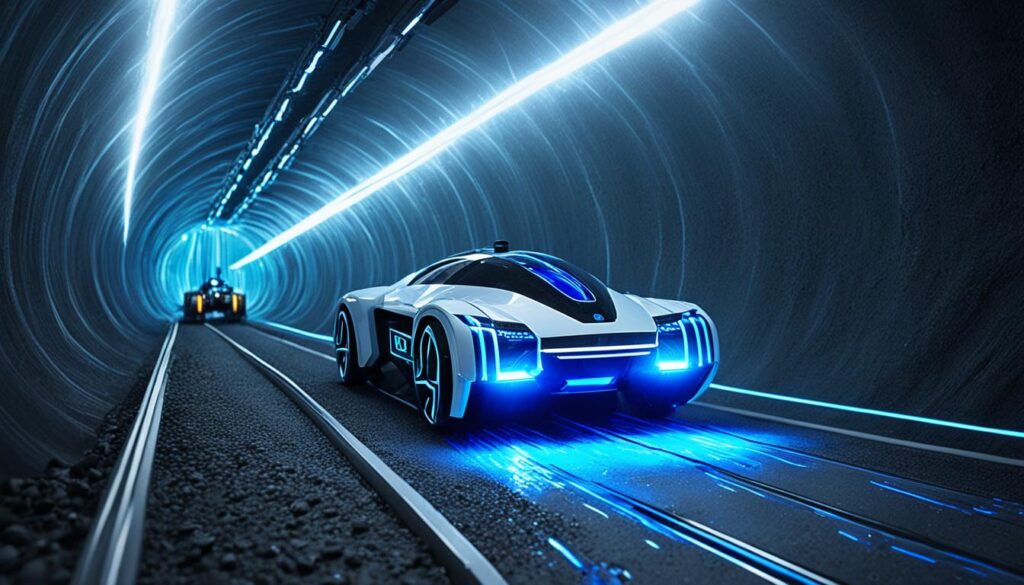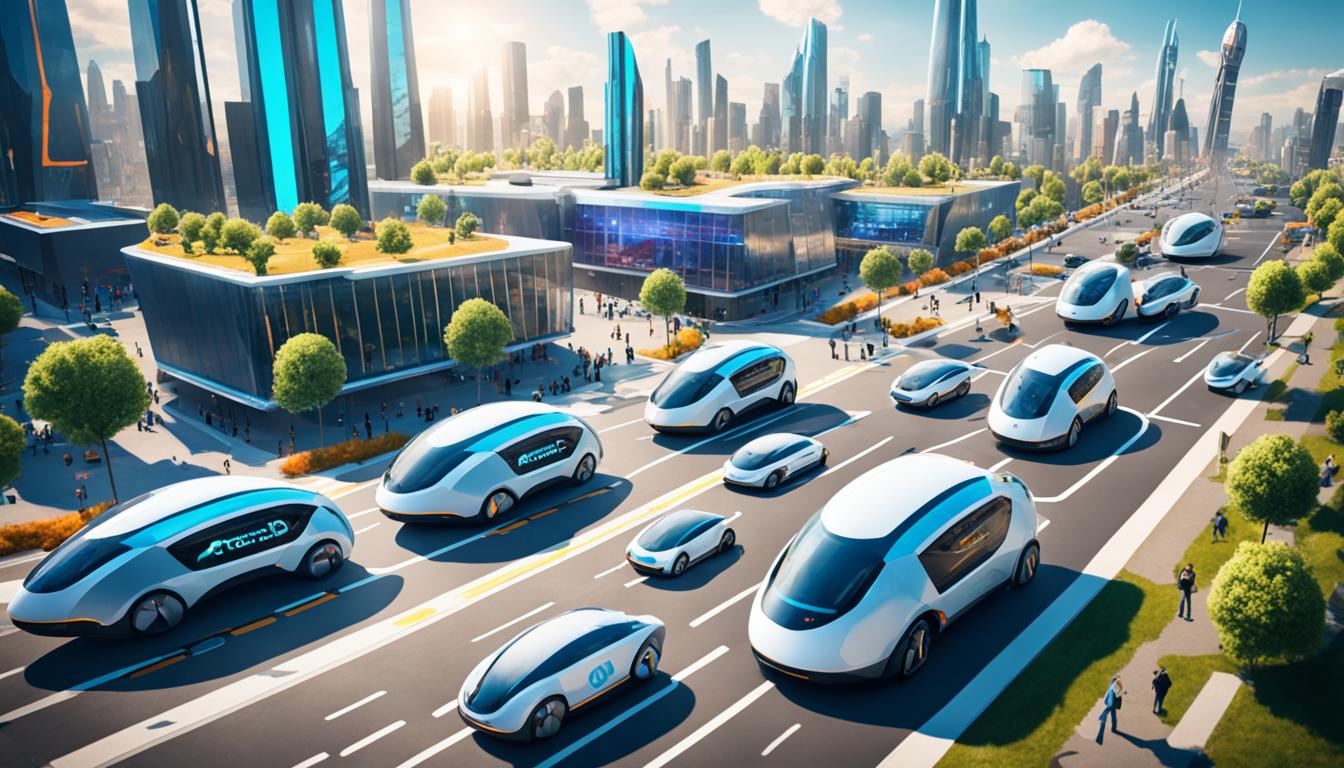“As an Amazon Associate I earn from qualifying purchases.” .
Imagine a world where machines think and adapt just like us. This is the promise of autonomous systems. They are changing how we live and work. Think of self-driving cars smoothly moving through cities. Or smart systems making manufacturing work easier. Autonomous technology is affecting our lives in big ways.
These aren’t like old automated machines. Autonomous systems use machine learning and artificial intelligence. They work on their own in changing environments. These smart systems can decide things, adapt, and solve tough problems. They help in many areas, from making supply chains better to changing healthcare for the better.
But, as these advanced systems develop, we must think about ethics and be clear about what they do. The future of autonomous systems, though, is very exciting. It marks a big step in technology and human achievement. We’re at the start of something amazing. This is the time to dive into the world of cognitive computing. See how robotic process automation and intelligent automation can truly change things.
Key Takeaways
- Autonomous systems leverage machine learning and AI to operate independently in dynamic environments.
- These intelligent machines can make decisions, adapt to changes, and solve complex problems across industries.
- Autonomous systems offer benefits in areas like supply chain management, healthcare, and assisting people with disabilities.
- While ethical concerns must be addressed, the future of autonomous systems holds significant promise for innovation.
- Autonomous systems aim to mimic and potentially surpass human cognitive abilities through advanced algorithms and neural networks.
Understanding Autonomous Systems
Within the world of smart tech, autonomous systems are different from automated systems. Automated systems do well with set tasks but can’t adjust to new or changing conditions. Autonomous systems use machine learning and artificial intelligence to do things in the real world. They make their own choices and adapt to changes.
Distinction from Automated Systems
The big difference between autonomous and automated systems is their independence. Automated ones are great at their tasks but can’t think outside their programming. Autonomous systems can understand their surroundings, learn, and make smart moves all on their own.
In tricky and unpredictable situations like city driving or exploring rough lands, autonomy really shines. Self-driving vehicles and robotic explorers need to make quick decisions. Automated systems just can’t handle this kind of variety, while autonomous systems thrive.
Human-Inspired Intelligence
The design of autonomous systems takes from the incredible decision-making of our brains. In artificial intelligence, experts are trying to match or even beat human thinking. They use advanced algorithms and networks to teach machines to think, learn, and decide.
This thinking, inspired by humans, allows autonomous systems to handle complex places, deal with surprises, and solve tough problems. As tech grows, adding machine learning and artificial intelligence to these systems promises new ways to innovate and solve challenges.
Autonomous Systems in Exploration
The DARPA Subterranean Challenge showed a big need for useful path planning and SLAM for autonomous robots. They explore hard-to-reach places like mines. These spots are tough because GPS is not always available. They have dangers, tricky terrain, and sensors can’t work well because of dust or fog.
Challenges in Tunnel Navigation
Tunnels and underground places are hard for robotic exploration. Creating new algorithms for path planning is key. These help make sure maps are right and the robot is safe. SLAM and path planning are very important. They make it possible for robots to work well even without GPS.

Look at this table. It underlines why it’s vital for robots to make their own decisions in space. It also shows some of the tough jobs they have to do:
| Scenario | Challenge | Solution |
|---|---|---|
| Long-distance Space Missions | Round-trip communication delays between Earth and Mars can be as long as 42 minutes. | Onboard autonomous decision-making for time-critical control. |
| Crewed Spacecraft Operations | Long-term crewed spacecraft like the International Space Station require significant real-time support from Earth. | Autonomous systems to handle complex space operations. |
| Machine Learning Hardware | Energy expenditure per operation and throughput acceleration metrics are crucial for neural network accelerators and neuromorphic computing in space. | Efficient hardware for onboard machine learning capabilities. |
| Cave Exploration | Challenging environments like caves require robust and coordinated control and data collection strategies. | Swarms of space vehicles for dispersed but coordinated exploration. |
| Fault Management | Space missions demand autonomous recovery from anomalies and faults to ensure mission continuity. | Advancing fault management technology across various mission phases. |
The Lunar Orbital Platform-Gateway aims to use artificial intelligence and machine learning to help in space for a long time. They also work on making sure future Mars missions are ready. Groups of space vehicles help a lot with collecting data and working well together in space.
Autonomous Robotic Mapping and Navigation
In the world of autonomous robotic mapping and navigation, experts work on high-tech systems. These help robots move and chart out tricky places well. An example is LAMP 2.0, which is excellent for big underground areas.
LAMP 2.0: Multi-Robot SLAM System
LAMP 2.0 has a special feature for finding loops and another for making routes better. It can even work with different types of movement and sensing data. This corrects errors and improves the view, making sure robots find their way and map spaces correctly. Many tests show that LAMP 2.0 works great in the real world, helping with big mapping tasks.
Path Planning and Frontier Exploration
Researchers are also making systems for autonomous mapping and exploration using drones. These systems use smart ways to explore new places, like advanced math and special plans to move. With these tools, drones can move and chart areas that are too dangerous or hard for people to go.
| Algorithm | Description | Application |
|---|---|---|
| A* Path Planning | Finds the shortest path between two points while avoiding obstacles | Robot navigation in cluttered environments |
| Dynamic Window Approach | Generates kinematically feasible trajectories based on current velocity and constraints | UAV navigation in dynamic environments |
| Frontier-based Exploration | Identifies and prioritizes unexplored areas based on sensor data | Mapping and exploration of unknown environments |
With such advanced tools and smart plans, researchers are making robots explore and map complex spaces better. This leads to new ways of using robots in many areas.
Autonomous Systems in GPS-Denied Environments
In the modern world, being able to find your way without GPS is more and more important. In places like mines, dense forests, and city canyons, GPS often doesn’t work well. To deal with this, experts are coming up with new ways for machines to explore these tough spots.
One method uses something called Partially Observable Markov Decision Processes (POMDP). This lets unmanned aerial vehicles (UAVs) move around without GPS, in places like mines or dense forests. It combines a few technologies like simultaneous localization and mapping (SLAM), visual odometry, and POMDP. These help the drones make smart decisions on their own, without human control.
Draper has shown that drones can be very smart and move on their own even without a lot of tech. They use a small, simple processor, and just an IMU and a single camera. This means drones can avoid obstacles well and make their own 3D maps, helping soldiers think less about flying them.
Draper’s software can work on little drones you can hold in your hand. But it can also fit on bigger drones or smart vehicles. This makes all kinds of machines more able to do new tasks all by themselves.
| Statistic | Value |
|---|---|
| Percentage of widely deployed autonomous systems relying on GNSS | Majority |
| Percentage of GNSS signal blockage affecting autonomous systems | Very susceptible |
| Percentage of environments where GNSS signals cannot be reliably used | Indoors, urban canyons, densely forested areas |
Draper is making robots and drones that work together better through a project called CSIRP. They are adding new AI to the drones so they can work in complicated 3D spaces. They are also improving how they test and include new tech in these machines.
- The autonomy software made by Draper can work in tough places where GPS doesn’t work well.
- This software helps make ordinary vehicles better at working alone in new ways.
Simultaneous Localization and Mapping (SLAM)
Simultaneous Localization and Mapping (SLAM) is a new tech letting robots find their way and map out spaces. Imagine a robot finding its way in a changing area by itself. This tech is key for robots to work on their own in different places.
The RHINO Autonomous Robot
The RHINO robot shows how SLAM works without relying on GPS. It explores mines with LiDAR and IMU tech. Thanks to the LIO-SAM system, RHINO makes detailed 3D maps while moving through tough spots.

RHINO is built to work on its own thanks to its advanced features. It uses many technologies to navigate tough terrains. It proves how SLAM can help robots deal with real challenges, leading to better robots in the future.
SLAM Techniques
There are many methods in the SLAM field, each suited for different needs. Some of these include:
- Monocular Visual SLAM: Uses just one camera.
- Stereo Visual SLAM: Uses two cameras for better depth awareness.
- RGB-D SLAM: Joins color and depth data for clearer maps.
- LiDAR SLAM: Uses LiDAR sensors for highly detailed maps.
- Visual-Inertial SLAM: Mixes visual and motion data for mapping.
Each method works well in certain places. For example, visual SLAM is great indoors, while LiDAR SLAM is best for outside areas.
Path Planning and Mapping
Path planning helps robots move autonomously. It uses maps from SLAM to find the best routes, avoiding obstacles and meeting goals.
Algorithms like A* and RRT help with path planning. Others, like LOAM and FGR, make laser data better for use in maps.
Calibration in Unstructured Environments
Understanding how to extrinsically calibrate a camera-LiDAR sensor fusion system is key in autonomous navigation. The paper with the Digital Object Identifier 10.1109/ACCESS.2020.3014121 introduces a new targetless calibration method. It’s designed for unstructured environments.
This method is able to accurately estimate the six-degree-of-freedom (6-DOF) transformation between cameras and LiDAR. It uses a special technique that looks at local edge features in arbitrary environments. This calculation helps in sensor calibration by measuring 3D-to-2D errors.
The Perspective-three-point (P3P) algorithm finds the best way to calibrate. A Kalman Filter is then used to make the calibration more stable in the presence of noise. Importantly, this targetless calibration method works without needing any special targets or structured areas. This makes it ideal for unstructured environments.
This method described in the article also doesn’t rely on having a lot of points in the cloud, which lessens the need for lots of scanning. The research proves the calibration is both accurate and strong against noise based on the Kitti dataset tests.
| Key Dates | Details |
|---|---|
| Received | July 10, 2020 |
| Accepted | July 26, 2020 |
| Date of Publication | August 4, 2020 |
| Date of Current Version | August 17, 2020 |
Autonomous Systems at Stanford
Stanford University leads the way in autonomous systems. The Autonomous Systems Lab (ASL) is a key player. They create smart algorithms that help machines think like we do. This lets robots move in tricky places and predict our actions, which is vital for their success.

Decision-Making Algorithms
The ASL works hard on decision-making algorithms. These let autonomous systems choose the best action in complex situations. By doing this, robots move efficiently and complete tasks well, even in changing environments.
Gripping Tools and Mobility
Stanford’s also big on making robots more flexible. The ASL tests special grips, like those inspired by geckos. These let robots grab things and do chores in space. Such grips boost robots’ abilities to work in tough places.
Exploring the Unknown
Exploring unseen places is a big deal at Stanford. They’ve built the ReachBot that goes to places on Mars where others can’t. This robot, with its smart grips and algorithms, is leading the charge in space exploration. It shows how future missions can solve Mars’ mysteries.
| Research Area | Description | Applications |
|---|---|---|
| Decision-Making Algorithms | Treat scenarios as cost-benefit optimization problems for autonomous systems to navigate complex environments and anticipate human reactions. | Aircraft collision avoidance, air traffic rerouting, autonomous vehicle fleet coordination. |
| Gripping Tools and Mobility | Develop advanced gripping tools like microspines and gecko-inspired adhesives to enhance robotic mobility and enable tasks like cargo handling and debris clearance in space. | Space exploration, Mars rover missions, handling hazardous materials. |
| Exploring the Unknown | Design autonomous systems like the ReachBot to explore unknown environments like caves and tunnels on Mars, pushing the boundaries of space exploration. | Planetary exploration, mapping unknown terrains, search and rescue operations. |
Challenges and Opportunities
Today, the world is excited about autonomous systems. But, we must be ready for the challenges and opportunities they bring. One big challenge is that jobs might change or go away. Autonomous systems might do things people have always done. Researchers at Stanford are finding ways to deal with this. For example, they’re looking at how to manage the money from tolls.
Autonomous systems also make us think about important things. We need to be clear about how they work, keep people safe, and follow laws. It’s very important to think about these things from the start. This way, we make sure these systems work well and don’t cause problems.
While autonomous systems can do a lot of good, their use comes with challenges too.
Still, autonomous systems offer a lot of chances for new and better things. They can make getting goods from one place to another better. They also help us explore places, like the icy moon Enceladus around Saturn, to look for life. These new technologies can change many areas for the better.
- Estlin et al. (2008) worked on making a Mars rover smarter. This way, the rover could make more decisions itself, helping in its missions.
- Frank (2008b) talked about how using more automation outside of Earth can save money. This means using autonomous systems can be good for business.
- Muscettola et al. (1998) showed the Remote Agent system. It was a big step in using AI to let spacecraft do more on their own. This helps in exploring space better.
As we move towards a future with autonomous systems, we need to find the right balance. We should use their power while making sure they don’t cause problems. The key is to innovate in a way that’s good for everyone. Working together in this, we can enjoy the best that these technologies offer. And, we can prevent any bad things that might come with them.
Conclusion
Today, we’re at a huge turning point with autonomous systems. Their advancements can change our lives. They promise to make big changes in many areas like transport, making things, health, and exploring space. These machines can work on their own, facing big challenges without our help.
But with these new chances, we also face big choices. We must think hard about the implications of creating and using these autonomous systems. We need to cover ethics, safety, and how to deal with possible job losses. Teamwork between scientists, policy makers, and business leaders can help us. We can make sure these technologies improve life for everyone.
The move towards more autonomous systems is already happening. People are leading the way, especially in cybernetics and in making machines that move. Looking to the future, we see endless chances. From robots discovering new worlds to smart systems bettering how we get products and changing how we treat illnesses. By being open to these advancements and solving their issues, we can move into a future where humans and machines work together. This cooperation will lead us to new beginnings and make our common journey richer.
FAQ
What are autonomous systems, and how do they differ from automated systems?
What challenges do autonomous systems face in exploring underground environments like mines and tunnels?
How do autonomous systems like RHINO navigate and map underground environments?
What techniques are used for calibrating camera-LiDAR systems in unstructured environments?
What research areas are being explored at Stanford University’s Autonomous Systems Lab?
What are some challenges and opportunities associated with the development of autonomous systems?
Source Links
- https://www.freshconsulting.com/insights/podcasts/the-future-of-autonomous-systems-2/
- https://www.techtarget.com/searchnetworking/definition/autonomous-system
- https://www.sbir.gov/node/1657371
- https://fri.cns.utexas.edu/research-streams/autonomous-robots
- https://www.draper.com/explore-solutions/autonomy-complex-environments
- https://research.statler.wvu.edu/research-categories/robotics/navigation-in-gps-denied-degraded-environments
- https://www.sciencedirect.com/science/article/abs/pii/S127096382200195X
- https://www.mathworks.com/discovery/slam.html
- https://en.wikipedia.org/wiki/Simultaneous_localization_and_mapping
- https://rua.ua.es/dspace/bitstream/10045/108689/1/Munoz-Banon_etal_2020_IEEEAccess.pdf
- https://aa.stanford.edu/research-impact/autonomous-systems-and-controls
- https://stanfordasl.github.io/robotics_seminar/
- https://iliad.stanford.edu/
- https://nap.nationalacademies.org/read/13043/chapter/17
- https://secwww.jhuapl.edu/techdigest/content/techdigest/pdf/V26-N04/26-04-Watson.pdf
“As an Amazon Associate I earn from qualifying purchases.” .



